Investment Appraisal Techniques: NPV, IRR, Payback Period
VerifiedAdded on 2023/06/11
|16
|3941
|239
AI Summary
This report is primarily concerned with assessing the understanding and ability to analyse capital investment decisions. It presents different investment appraisal techniques such as net present value, internal rate of return, payback period and accounting rate of return to the finance director of Tap Vim Plc. The report covers how these techniques will help the company in selecting the best, suitable and highly profitable investment projects out of the alternative projects. Real-life examples are provided to present an accurate report to the finance director of the company.
Contribute Materials
Your contribution can guide someone’s learning journey. Share your
documents today.

Primarily concerned with
assessing your understanding
of and ability to analyse
capital investment decisions
assessing your understanding
of and ability to analyse
capital investment decisions
Secure Best Marks with AI Grader
Need help grading? Try our AI Grader for instant feedback on your assignments.

Table of Contents
INTRODUCTION...........................................................................................................................3
Investment Appraisal Techniques................................................................................................3
CONCLUSION..............................................................................................................................13
REFERENCES................................................................................................................................1
INTRODUCTION...........................................................................................................................3
Investment Appraisal Techniques................................................................................................3
CONCLUSION..............................................................................................................................13
REFERENCES................................................................................................................................1
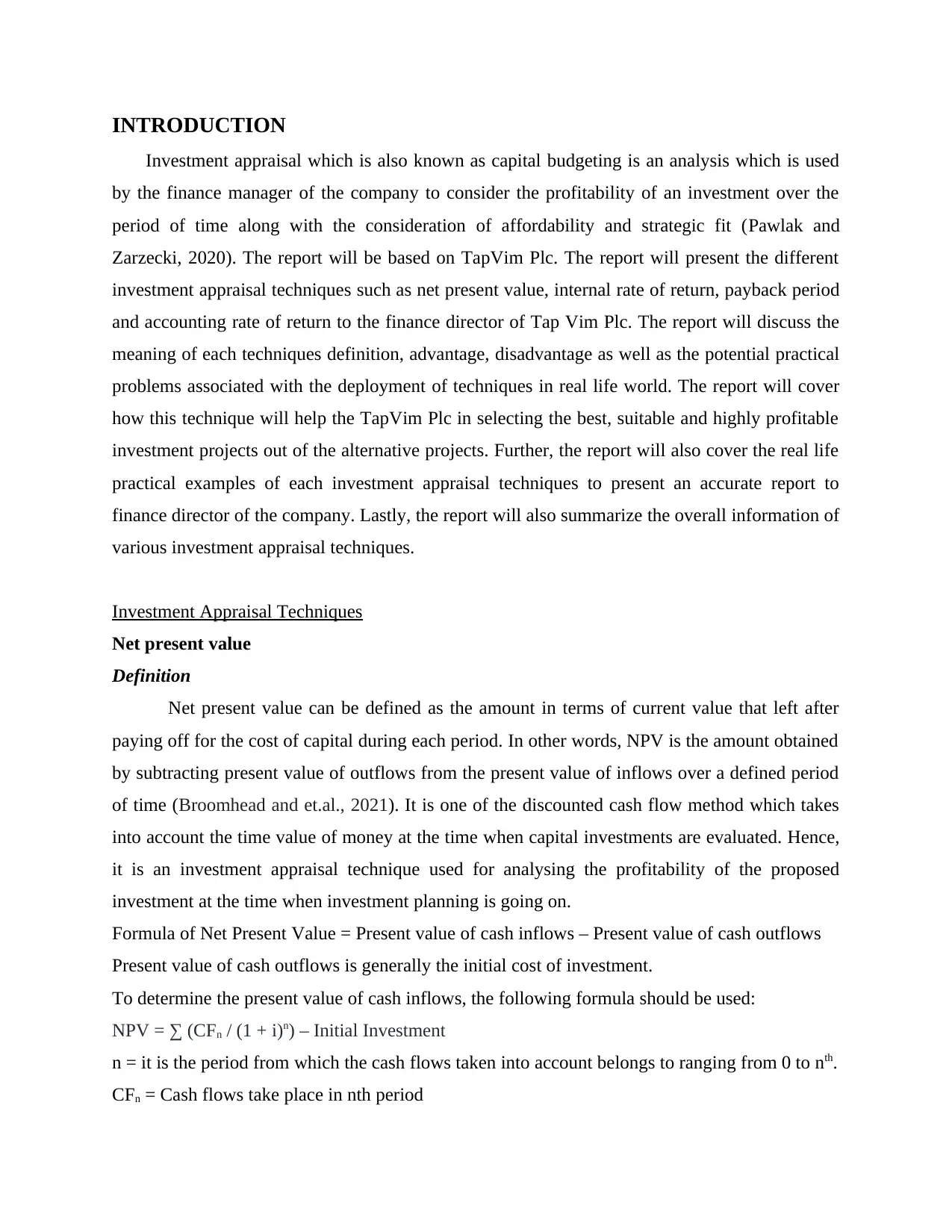
INTRODUCTION
Investment appraisal which is also known as capital budgeting is an analysis which is used
by the finance manager of the company to consider the profitability of an investment over the
period of time along with the consideration of affordability and strategic fit (Pawlak and
Zarzecki, 2020). The report will be based on TapVim Plc. The report will present the different
investment appraisal techniques such as net present value, internal rate of return, payback period
and accounting rate of return to the finance director of Tap Vim Plc. The report will discuss the
meaning of each techniques definition, advantage, disadvantage as well as the potential practical
problems associated with the deployment of techniques in real life world. The report will cover
how this technique will help the TapVim Plc in selecting the best, suitable and highly profitable
investment projects out of the alternative projects. Further, the report will also cover the real life
practical examples of each investment appraisal techniques to present an accurate report to
finance director of the company. Lastly, the report will also summarize the overall information of
various investment appraisal techniques.
Investment Appraisal Techniques
Net present value
Definition
Net present value can be defined as the amount in terms of current value that left after
paying off for the cost of capital during each period. In other words, NPV is the amount obtained
by subtracting present value of outflows from the present value of inflows over a defined period
of time (Broomhead and et.al., 2021). It is one of the discounted cash flow method which takes
into account the time value of money at the time when capital investments are evaluated. Hence,
it is an investment appraisal technique used for analysing the profitability of the proposed
investment at the time when investment planning is going on.
Formula of Net Present Value = Present value of cash inflows – Present value of cash outflows
Present value of cash outflows is generally the initial cost of investment.
To determine the present value of cash inflows, the following formula should be used:
NPV = ∑ (CFn / (1 + i)n) – Initial Investment
n = it is the period from which the cash flows taken into account belongs to ranging from 0 to nth.
CFn = Cash flows take place in nth period
Investment appraisal which is also known as capital budgeting is an analysis which is used
by the finance manager of the company to consider the profitability of an investment over the
period of time along with the consideration of affordability and strategic fit (Pawlak and
Zarzecki, 2020). The report will be based on TapVim Plc. The report will present the different
investment appraisal techniques such as net present value, internal rate of return, payback period
and accounting rate of return to the finance director of Tap Vim Plc. The report will discuss the
meaning of each techniques definition, advantage, disadvantage as well as the potential practical
problems associated with the deployment of techniques in real life world. The report will cover
how this technique will help the TapVim Plc in selecting the best, suitable and highly profitable
investment projects out of the alternative projects. Further, the report will also cover the real life
practical examples of each investment appraisal techniques to present an accurate report to
finance director of the company. Lastly, the report will also summarize the overall information of
various investment appraisal techniques.
Investment Appraisal Techniques
Net present value
Definition
Net present value can be defined as the amount in terms of current value that left after
paying off for the cost of capital during each period. In other words, NPV is the amount obtained
by subtracting present value of outflows from the present value of inflows over a defined period
of time (Broomhead and et.al., 2021). It is one of the discounted cash flow method which takes
into account the time value of money at the time when capital investments are evaluated. Hence,
it is an investment appraisal technique used for analysing the profitability of the proposed
investment at the time when investment planning is going on.
Formula of Net Present Value = Present value of cash inflows – Present value of cash outflows
Present value of cash outflows is generally the initial cost of investment.
To determine the present value of cash inflows, the following formula should be used:
NPV = ∑ (CFn / (1 + i)n) – Initial Investment
n = it is the period from which the cash flows taken into account belongs to ranging from 0 to nth.
CFn = Cash flows take place in nth period
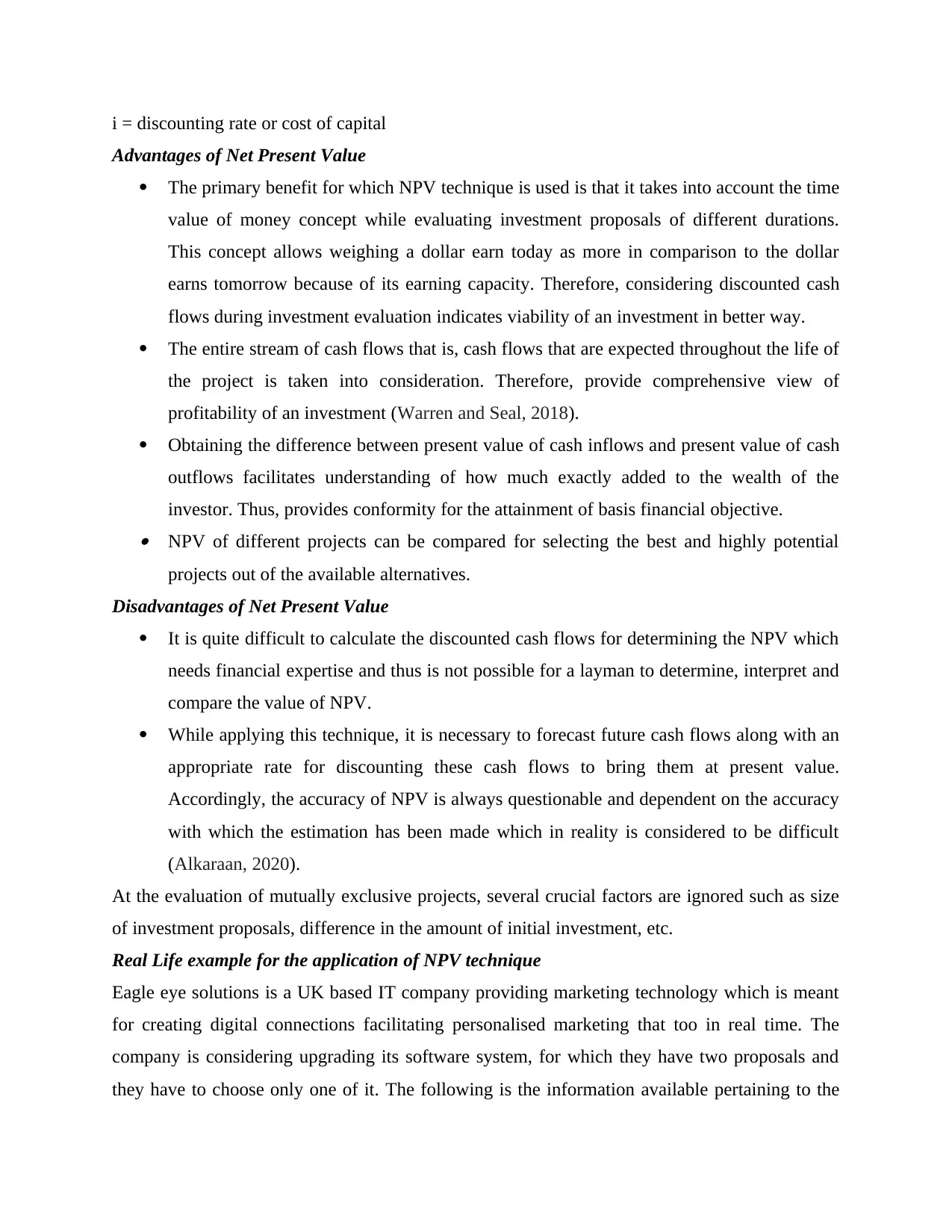
i = discounting rate or cost of capital
Advantages of Net Present Value
The primary benefit for which NPV technique is used is that it takes into account the time
value of money concept while evaluating investment proposals of different durations.
This concept allows weighing a dollar earn today as more in comparison to the dollar
earns tomorrow because of its earning capacity. Therefore, considering discounted cash
flows during investment evaluation indicates viability of an investment in better way.
The entire stream of cash flows that is, cash flows that are expected throughout the life of
the project is taken into consideration. Therefore, provide comprehensive view of
profitability of an investment (Warren and Seal, 2018).
Obtaining the difference between present value of cash inflows and present value of cash
outflows facilitates understanding of how much exactly added to the wealth of the
investor. Thus, provides conformity for the attainment of basis financial objective. NPV of different projects can be compared for selecting the best and highly potential
projects out of the available alternatives.
Disadvantages of Net Present Value
It is quite difficult to calculate the discounted cash flows for determining the NPV which
needs financial expertise and thus is not possible for a layman to determine, interpret and
compare the value of NPV.
While applying this technique, it is necessary to forecast future cash flows along with an
appropriate rate for discounting these cash flows to bring them at present value.
Accordingly, the accuracy of NPV is always questionable and dependent on the accuracy
with which the estimation has been made which in reality is considered to be difficult
(Alkaraan, 2020).
At the evaluation of mutually exclusive projects, several crucial factors are ignored such as size
of investment proposals, difference in the amount of initial investment, etc.
Real Life example for the application of NPV technique
Eagle eye solutions is a UK based IT company providing marketing technology which is meant
for creating digital connections facilitating personalised marketing that too in real time. The
company is considering upgrading its software system, for which they have two proposals and
they have to choose only one of it. The following is the information available pertaining to the
Advantages of Net Present Value
The primary benefit for which NPV technique is used is that it takes into account the time
value of money concept while evaluating investment proposals of different durations.
This concept allows weighing a dollar earn today as more in comparison to the dollar
earns tomorrow because of its earning capacity. Therefore, considering discounted cash
flows during investment evaluation indicates viability of an investment in better way.
The entire stream of cash flows that is, cash flows that are expected throughout the life of
the project is taken into consideration. Therefore, provide comprehensive view of
profitability of an investment (Warren and Seal, 2018).
Obtaining the difference between present value of cash inflows and present value of cash
outflows facilitates understanding of how much exactly added to the wealth of the
investor. Thus, provides conformity for the attainment of basis financial objective. NPV of different projects can be compared for selecting the best and highly potential
projects out of the available alternatives.
Disadvantages of Net Present Value
It is quite difficult to calculate the discounted cash flows for determining the NPV which
needs financial expertise and thus is not possible for a layman to determine, interpret and
compare the value of NPV.
While applying this technique, it is necessary to forecast future cash flows along with an
appropriate rate for discounting these cash flows to bring them at present value.
Accordingly, the accuracy of NPV is always questionable and dependent on the accuracy
with which the estimation has been made which in reality is considered to be difficult
(Alkaraan, 2020).
At the evaluation of mutually exclusive projects, several crucial factors are ignored such as size
of investment proposals, difference in the amount of initial investment, etc.
Real Life example for the application of NPV technique
Eagle eye solutions is a UK based IT company providing marketing technology which is meant
for creating digital connections facilitating personalised marketing that too in real time. The
company is considering upgrading its software system, for which they have two proposals and
they have to choose only one of it. The following is the information available pertaining to the
Secure Best Marks with AI Grader
Need help grading? Try our AI Grader for instant feedback on your assignments.
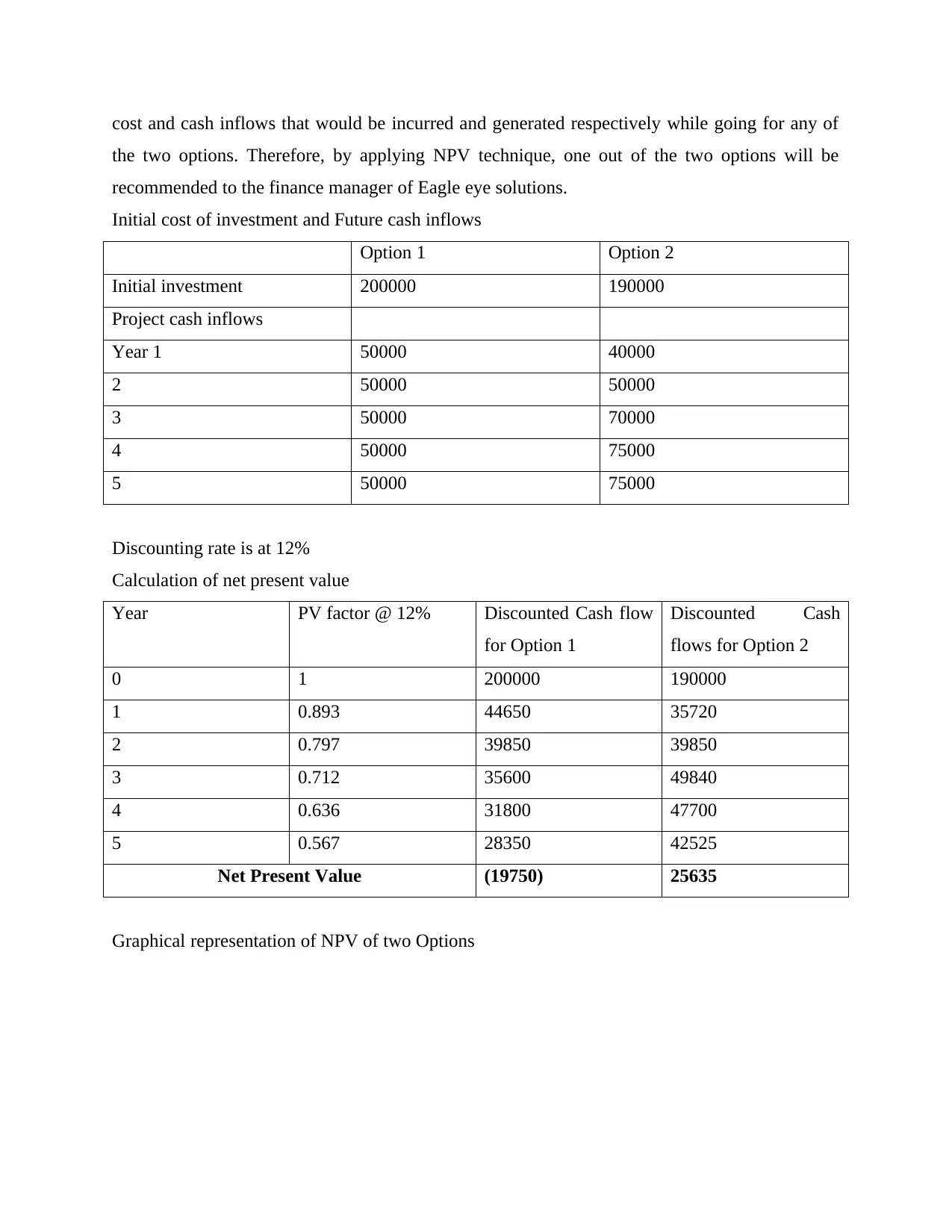
cost and cash inflows that would be incurred and generated respectively while going for any of
the two options. Therefore, by applying NPV technique, one out of the two options will be
recommended to the finance manager of Eagle eye solutions.
Initial cost of investment and Future cash inflows
Option 1 Option 2
Initial investment 200000 190000
Project cash inflows
Year 1 50000 40000
2 50000 50000
3 50000 70000
4 50000 75000
5 50000 75000
Discounting rate is at 12%
Calculation of net present value
Year PV factor @ 12% Discounted Cash flow
for Option 1
Discounted Cash
flows for Option 2
0 1 200000 190000
1 0.893 44650 35720
2 0.797 39850 39850
3 0.712 35600 49840
4 0.636 31800 47700
5 0.567 28350 42525
Net Present Value (19750) 25635
Graphical representation of NPV of two Options
the two options. Therefore, by applying NPV technique, one out of the two options will be
recommended to the finance manager of Eagle eye solutions.
Initial cost of investment and Future cash inflows
Option 1 Option 2
Initial investment 200000 190000
Project cash inflows
Year 1 50000 40000
2 50000 50000
3 50000 70000
4 50000 75000
5 50000 75000
Discounting rate is at 12%
Calculation of net present value
Year PV factor @ 12% Discounted Cash flow
for Option 1
Discounted Cash
flows for Option 2
0 1 200000 190000
1 0.893 44650 35720
2 0.797 39850 39850
3 0.712 35600 49840
4 0.636 31800 47700
5 0.567 28350 42525
Net Present Value (19750) 25635
Graphical representation of NPV of two Options
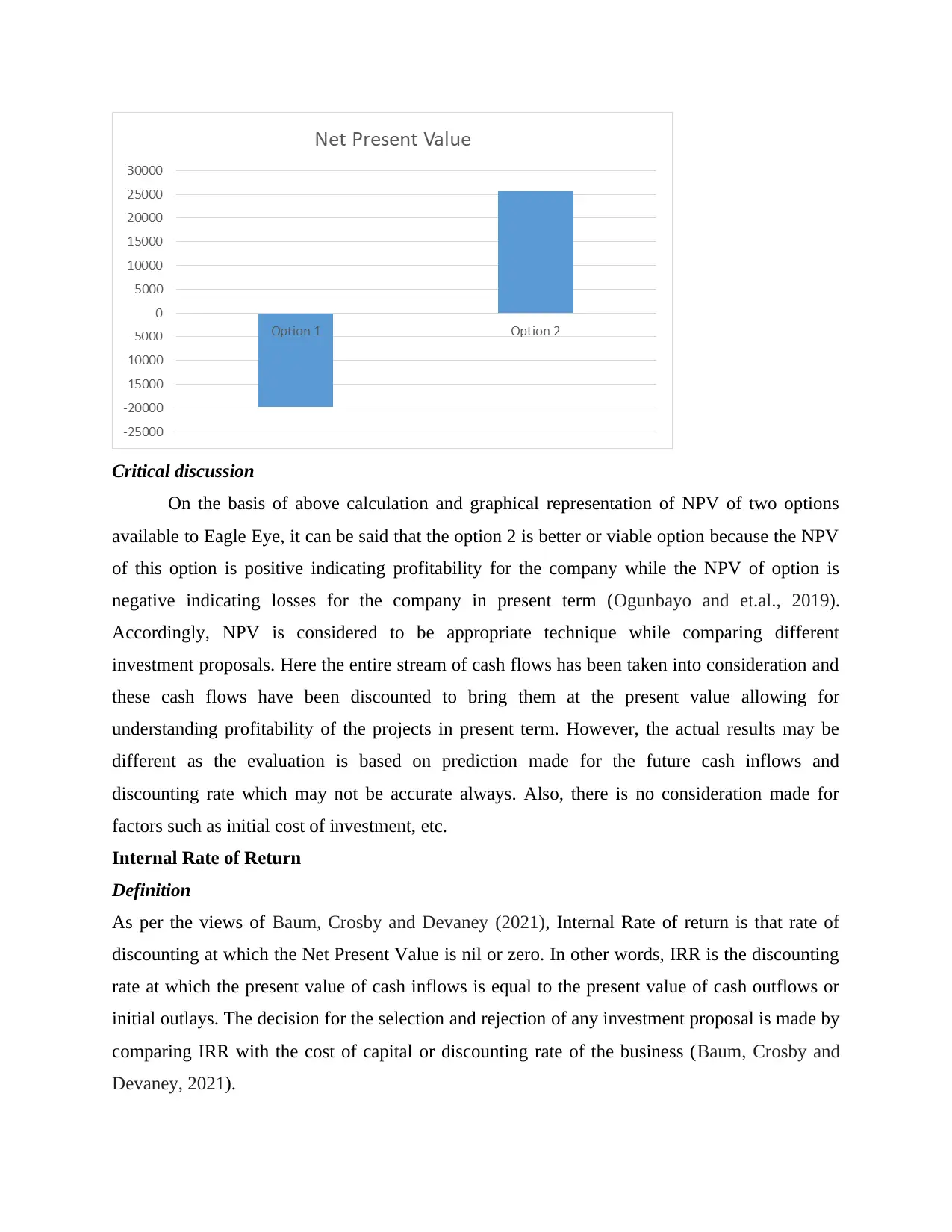
Critical discussion
On the basis of above calculation and graphical representation of NPV of two options
available to Eagle Eye, it can be said that the option 2 is better or viable option because the NPV
of this option is positive indicating profitability for the company while the NPV of option is
negative indicating losses for the company in present term (Ogunbayo and et.al., 2019).
Accordingly, NPV is considered to be appropriate technique while comparing different
investment proposals. Here the entire stream of cash flows has been taken into consideration and
these cash flows have been discounted to bring them at the present value allowing for
understanding profitability of the projects in present term. However, the actual results may be
different as the evaluation is based on prediction made for the future cash inflows and
discounting rate which may not be accurate always. Also, there is no consideration made for
factors such as initial cost of investment, etc.
Internal Rate of Return
Definition
As per the views of Baum, Crosby and Devaney (2021), Internal Rate of return is that rate of
discounting at which the Net Present Value is nil or zero. In other words, IRR is the discounting
rate at which the present value of cash inflows is equal to the present value of cash outflows or
initial outlays. The decision for the selection and rejection of any investment proposal is made by
comparing IRR with the cost of capital or discounting rate of the business (Baum, Crosby and
Devaney, 2021).
On the basis of above calculation and graphical representation of NPV of two options
available to Eagle Eye, it can be said that the option 2 is better or viable option because the NPV
of this option is positive indicating profitability for the company while the NPV of option is
negative indicating losses for the company in present term (Ogunbayo and et.al., 2019).
Accordingly, NPV is considered to be appropriate technique while comparing different
investment proposals. Here the entire stream of cash flows has been taken into consideration and
these cash flows have been discounted to bring them at the present value allowing for
understanding profitability of the projects in present term. However, the actual results may be
different as the evaluation is based on prediction made for the future cash inflows and
discounting rate which may not be accurate always. Also, there is no consideration made for
factors such as initial cost of investment, etc.
Internal Rate of Return
Definition
As per the views of Baum, Crosby and Devaney (2021), Internal Rate of return is that rate of
discounting at which the Net Present Value is nil or zero. In other words, IRR is the discounting
rate at which the present value of cash inflows is equal to the present value of cash outflows or
initial outlays. The decision for the selection and rejection of any investment proposal is made by
comparing IRR with the cost of capital or discounting rate of the business (Baum, Crosby and
Devaney, 2021).
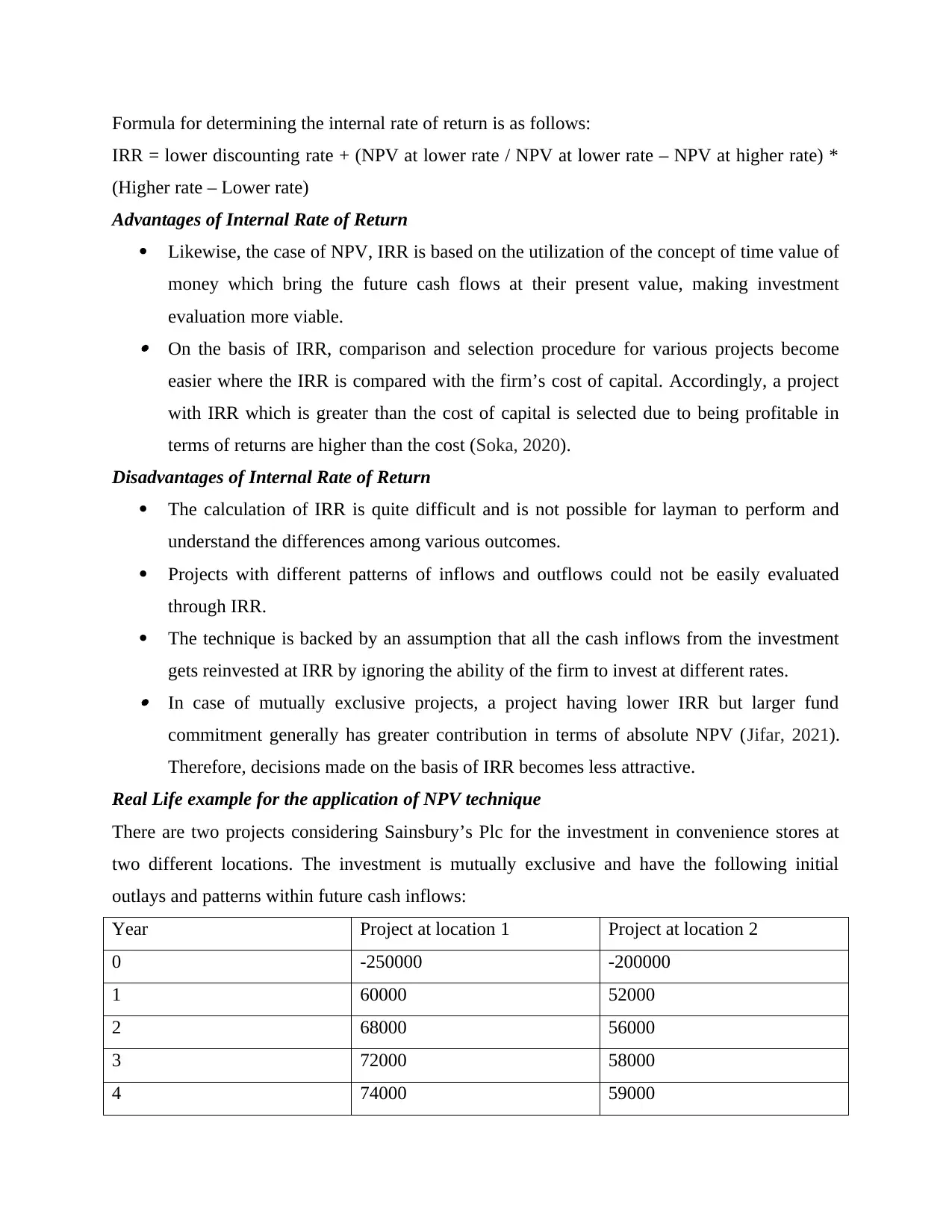
Formula for determining the internal rate of return is as follows:
IRR = lower discounting rate + (NPV at lower rate / NPV at lower rate – NPV at higher rate) *
(Higher rate – Lower rate)
Advantages of Internal Rate of Return
Likewise, the case of NPV, IRR is based on the utilization of the concept of time value of
money which bring the future cash flows at their present value, making investment
evaluation more viable. On the basis of IRR, comparison and selection procedure for various projects become
easier where the IRR is compared with the firm’s cost of capital. Accordingly, a project
with IRR which is greater than the cost of capital is selected due to being profitable in
terms of returns are higher than the cost (Soka, 2020).
Disadvantages of Internal Rate of Return
The calculation of IRR is quite difficult and is not possible for layman to perform and
understand the differences among various outcomes.
Projects with different patterns of inflows and outflows could not be easily evaluated
through IRR.
The technique is backed by an assumption that all the cash inflows from the investment
gets reinvested at IRR by ignoring the ability of the firm to invest at different rates. In case of mutually exclusive projects, a project having lower IRR but larger fund
commitment generally has greater contribution in terms of absolute NPV (Jifar, 2021).
Therefore, decisions made on the basis of IRR becomes less attractive.
Real Life example for the application of NPV technique
There are two projects considering Sainsbury’s Plc for the investment in convenience stores at
two different locations. The investment is mutually exclusive and have the following initial
outlays and patterns within future cash inflows:
Year Project at location 1 Project at location 2
0 -250000 -200000
1 60000 52000
2 68000 56000
3 72000 58000
4 74000 59000
IRR = lower discounting rate + (NPV at lower rate / NPV at lower rate – NPV at higher rate) *
(Higher rate – Lower rate)
Advantages of Internal Rate of Return
Likewise, the case of NPV, IRR is based on the utilization of the concept of time value of
money which bring the future cash flows at their present value, making investment
evaluation more viable. On the basis of IRR, comparison and selection procedure for various projects become
easier where the IRR is compared with the firm’s cost of capital. Accordingly, a project
with IRR which is greater than the cost of capital is selected due to being profitable in
terms of returns are higher than the cost (Soka, 2020).
Disadvantages of Internal Rate of Return
The calculation of IRR is quite difficult and is not possible for layman to perform and
understand the differences among various outcomes.
Projects with different patterns of inflows and outflows could not be easily evaluated
through IRR.
The technique is backed by an assumption that all the cash inflows from the investment
gets reinvested at IRR by ignoring the ability of the firm to invest at different rates. In case of mutually exclusive projects, a project having lower IRR but larger fund
commitment generally has greater contribution in terms of absolute NPV (Jifar, 2021).
Therefore, decisions made on the basis of IRR becomes less attractive.
Real Life example for the application of NPV technique
There are two projects considering Sainsbury’s Plc for the investment in convenience stores at
two different locations. The investment is mutually exclusive and have the following initial
outlays and patterns within future cash inflows:
Year Project at location 1 Project at location 2
0 -250000 -200000
1 60000 52000
2 68000 56000
3 72000 58000
4 74000 59000
Paraphrase This Document
Need a fresh take? Get an instant paraphrase of this document with our AI Paraphraser
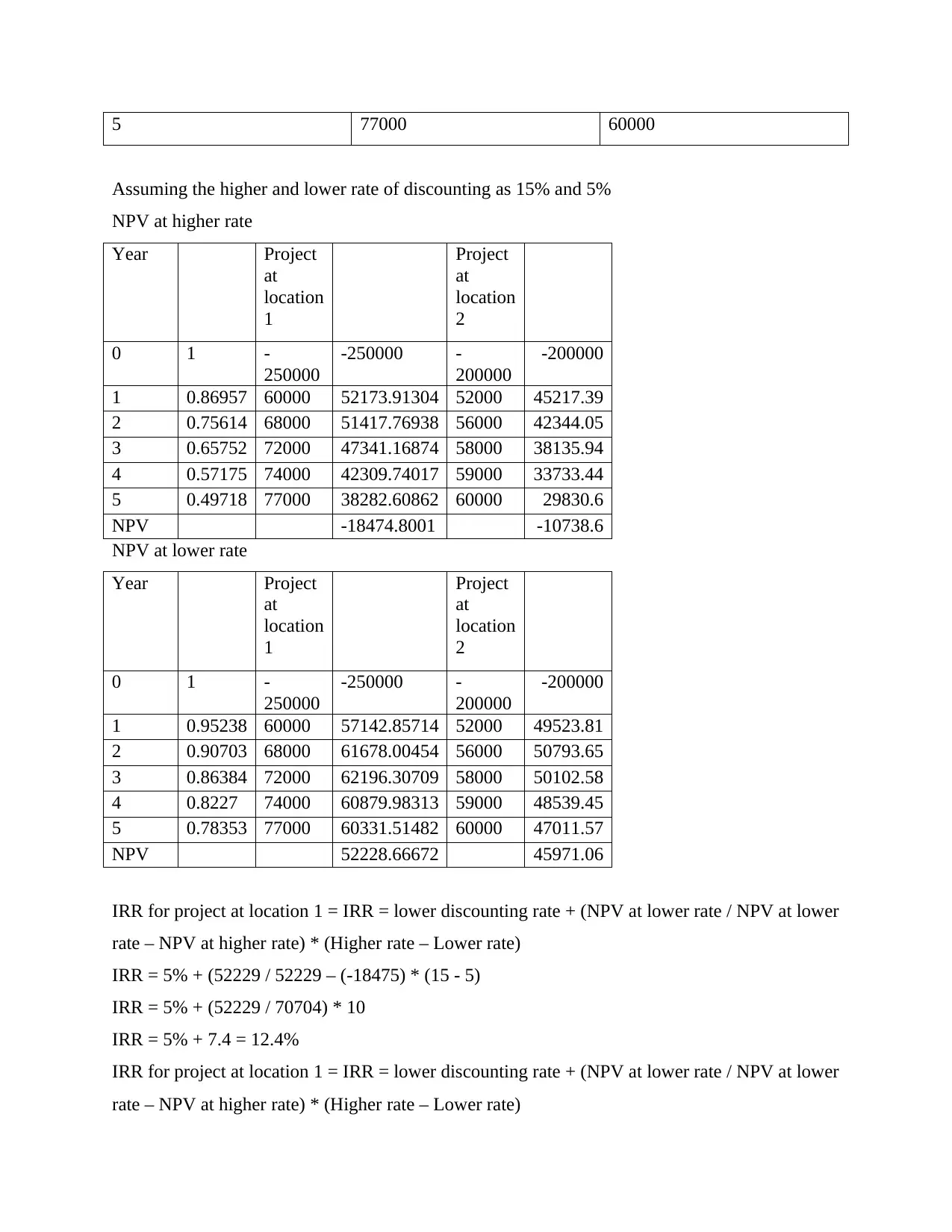
5 77000 60000
Assuming the higher and lower rate of discounting as 15% and 5%
NPV at higher rate
Year Project
at
location
1
Project
at
location
2
0 1 -
250000
-250000 -
200000
-200000
1 0.86957 60000 52173.91304 52000 45217.39
2 0.75614 68000 51417.76938 56000 42344.05
3 0.65752 72000 47341.16874 58000 38135.94
4 0.57175 74000 42309.74017 59000 33733.44
5 0.49718 77000 38282.60862 60000 29830.6
NPV -18474.8001 -10738.6
NPV at lower rate
Year Project
at
location
1
Project
at
location
2
0 1 -
250000
-250000 -
200000
-200000
1 0.95238 60000 57142.85714 52000 49523.81
2 0.90703 68000 61678.00454 56000 50793.65
3 0.86384 72000 62196.30709 58000 50102.58
4 0.8227 74000 60879.98313 59000 48539.45
5 0.78353 77000 60331.51482 60000 47011.57
NPV 52228.66672 45971.06
IRR for project at location 1 = IRR = lower discounting rate + (NPV at lower rate / NPV at lower
rate – NPV at higher rate) * (Higher rate – Lower rate)
IRR = 5% + (52229 / 52229 – (-18475) * (15 - 5)
IRR = 5% + (52229 / 70704) * 10
IRR = 5% + 7.4 = 12.4%
IRR for project at location 1 = IRR = lower discounting rate + (NPV at lower rate / NPV at lower
rate – NPV at higher rate) * (Higher rate – Lower rate)
Assuming the higher and lower rate of discounting as 15% and 5%
NPV at higher rate
Year Project
at
location
1
Project
at
location
2
0 1 -
250000
-250000 -
200000
-200000
1 0.86957 60000 52173.91304 52000 45217.39
2 0.75614 68000 51417.76938 56000 42344.05
3 0.65752 72000 47341.16874 58000 38135.94
4 0.57175 74000 42309.74017 59000 33733.44
5 0.49718 77000 38282.60862 60000 29830.6
NPV -18474.8001 -10738.6
NPV at lower rate
Year Project
at
location
1
Project
at
location
2
0 1 -
250000
-250000 -
200000
-200000
1 0.95238 60000 57142.85714 52000 49523.81
2 0.90703 68000 61678.00454 56000 50793.65
3 0.86384 72000 62196.30709 58000 50102.58
4 0.8227 74000 60879.98313 59000 48539.45
5 0.78353 77000 60331.51482 60000 47011.57
NPV 52228.66672 45971.06
IRR for project at location 1 = IRR = lower discounting rate + (NPV at lower rate / NPV at lower
rate – NPV at higher rate) * (Higher rate – Lower rate)
IRR = 5% + (52229 / 52229 – (-18475) * (15 - 5)
IRR = 5% + (52229 / 70704) * 10
IRR = 5% + 7.4 = 12.4%
IRR for project at location 1 = IRR = lower discounting rate + (NPV at lower rate / NPV at lower
rate – NPV at higher rate) * (Higher rate – Lower rate)
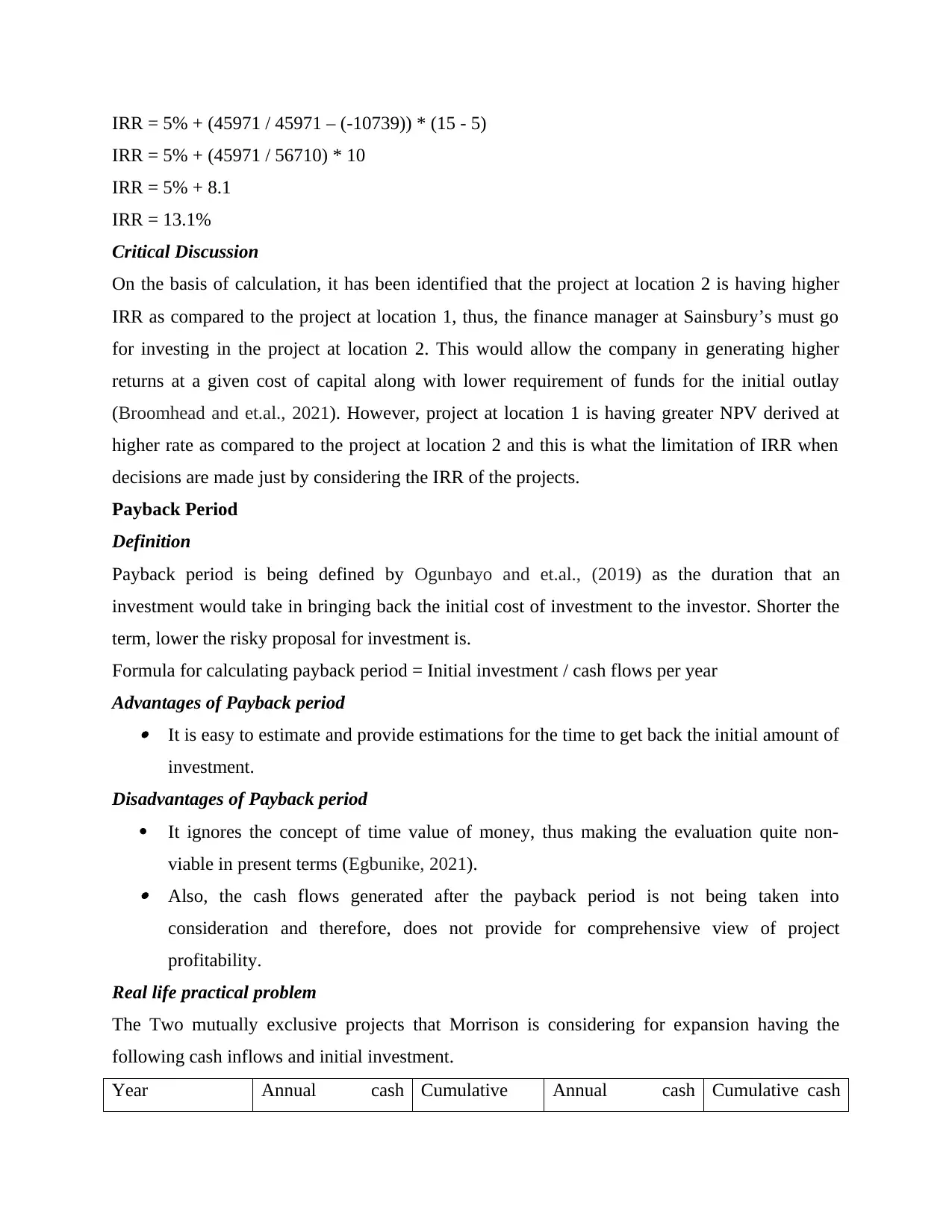
IRR = 5% + (45971 / 45971 – (-10739)) * (15 - 5)
IRR = 5% + (45971 / 56710) * 10
IRR = 5% + 8.1
IRR = 13.1%
Critical Discussion
On the basis of calculation, it has been identified that the project at location 2 is having higher
IRR as compared to the project at location 1, thus, the finance manager at Sainsbury’s must go
for investing in the project at location 2. This would allow the company in generating higher
returns at a given cost of capital along with lower requirement of funds for the initial outlay
(Broomhead and et.al., 2021). However, project at location 1 is having greater NPV derived at
higher rate as compared to the project at location 2 and this is what the limitation of IRR when
decisions are made just by considering the IRR of the projects.
Payback Period
Definition
Payback period is being defined by Ogunbayo and et.al., (2019) as the duration that an
investment would take in bringing back the initial cost of investment to the investor. Shorter the
term, lower the risky proposal for investment is.
Formula for calculating payback period = Initial investment / cash flows per year
Advantages of Payback period It is easy to estimate and provide estimations for the time to get back the initial amount of
investment.
Disadvantages of Payback period
It ignores the concept of time value of money, thus making the evaluation quite non-
viable in present terms (Egbunike, 2021). Also, the cash flows generated after the payback period is not being taken into
consideration and therefore, does not provide for comprehensive view of project
profitability.
Real life practical problem
The Two mutually exclusive projects that Morrison is considering for expansion having the
following cash inflows and initial investment.
Year Annual cash Cumulative Annual cash Cumulative cash
IRR = 5% + (45971 / 56710) * 10
IRR = 5% + 8.1
IRR = 13.1%
Critical Discussion
On the basis of calculation, it has been identified that the project at location 2 is having higher
IRR as compared to the project at location 1, thus, the finance manager at Sainsbury’s must go
for investing in the project at location 2. This would allow the company in generating higher
returns at a given cost of capital along with lower requirement of funds for the initial outlay
(Broomhead and et.al., 2021). However, project at location 1 is having greater NPV derived at
higher rate as compared to the project at location 2 and this is what the limitation of IRR when
decisions are made just by considering the IRR of the projects.
Payback Period
Definition
Payback period is being defined by Ogunbayo and et.al., (2019) as the duration that an
investment would take in bringing back the initial cost of investment to the investor. Shorter the
term, lower the risky proposal for investment is.
Formula for calculating payback period = Initial investment / cash flows per year
Advantages of Payback period It is easy to estimate and provide estimations for the time to get back the initial amount of
investment.
Disadvantages of Payback period
It ignores the concept of time value of money, thus making the evaluation quite non-
viable in present terms (Egbunike, 2021). Also, the cash flows generated after the payback period is not being taken into
consideration and therefore, does not provide for comprehensive view of project
profitability.
Real life practical problem
The Two mutually exclusive projects that Morrison is considering for expansion having the
following cash inflows and initial investment.
Year Annual cash Cumulative Annual cash Cumulative cash
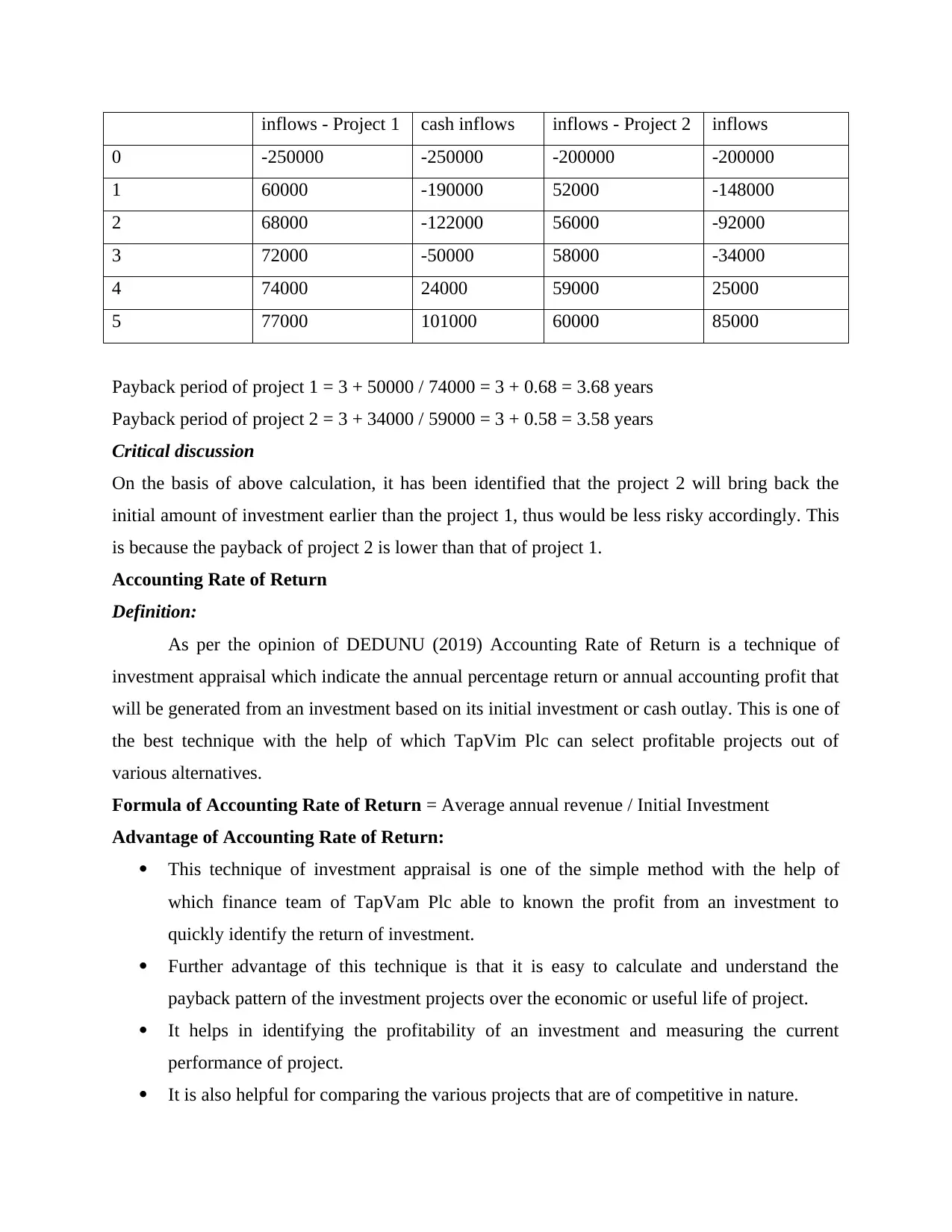
inflows - Project 1 cash inflows inflows - Project 2 inflows
0 -250000 -250000 -200000 -200000
1 60000 -190000 52000 -148000
2 68000 -122000 56000 -92000
3 72000 -50000 58000 -34000
4 74000 24000 59000 25000
5 77000 101000 60000 85000
Payback period of project 1 = 3 + 50000 / 74000 = 3 + 0.68 = 3.68 years
Payback period of project 2 = 3 + 34000 / 59000 = 3 + 0.58 = 3.58 years
Critical discussion
On the basis of above calculation, it has been identified that the project 2 will bring back the
initial amount of investment earlier than the project 1, thus would be less risky accordingly. This
is because the payback of project 2 is lower than that of project 1.
Accounting Rate of Return
Definition:
As per the opinion of DEDUNU (2019) Accounting Rate of Return is a technique of
investment appraisal which indicate the annual percentage return or annual accounting profit that
will be generated from an investment based on its initial investment or cash outlay. This is one of
the best technique with the help of which TapVim Plc can select profitable projects out of
various alternatives.
Formula of Accounting Rate of Return = Average annual revenue / Initial Investment
Advantage of Accounting Rate of Return:
This technique of investment appraisal is one of the simple method with the help of
which finance team of TapVam Plc able to known the profit from an investment to
quickly identify the return of investment.
Further advantage of this technique is that it is easy to calculate and understand the
payback pattern of the investment projects over the economic or useful life of project.
It helps in identifying the profitability of an investment and measuring the current
performance of project.
It is also helpful for comparing the various projects that are of competitive in nature.
0 -250000 -250000 -200000 -200000
1 60000 -190000 52000 -148000
2 68000 -122000 56000 -92000
3 72000 -50000 58000 -34000
4 74000 24000 59000 25000
5 77000 101000 60000 85000
Payback period of project 1 = 3 + 50000 / 74000 = 3 + 0.68 = 3.68 years
Payback period of project 2 = 3 + 34000 / 59000 = 3 + 0.58 = 3.58 years
Critical discussion
On the basis of above calculation, it has been identified that the project 2 will bring back the
initial amount of investment earlier than the project 1, thus would be less risky accordingly. This
is because the payback of project 2 is lower than that of project 1.
Accounting Rate of Return
Definition:
As per the opinion of DEDUNU (2019) Accounting Rate of Return is a technique of
investment appraisal which indicate the annual percentage return or annual accounting profit that
will be generated from an investment based on its initial investment or cash outlay. This is one of
the best technique with the help of which TapVim Plc can select profitable projects out of
various alternatives.
Formula of Accounting Rate of Return = Average annual revenue / Initial Investment
Advantage of Accounting Rate of Return:
This technique of investment appraisal is one of the simple method with the help of
which finance team of TapVam Plc able to known the profit from an investment to
quickly identify the return of investment.
Further advantage of this technique is that it is easy to calculate and understand the
payback pattern of the investment projects over the economic or useful life of project.
It helps in identifying the profitability of an investment and measuring the current
performance of project.
It is also helpful for comparing the various projects that are of competitive in nature.
Secure Best Marks with AI Grader
Need help grading? Try our AI Grader for instant feedback on your assignments.
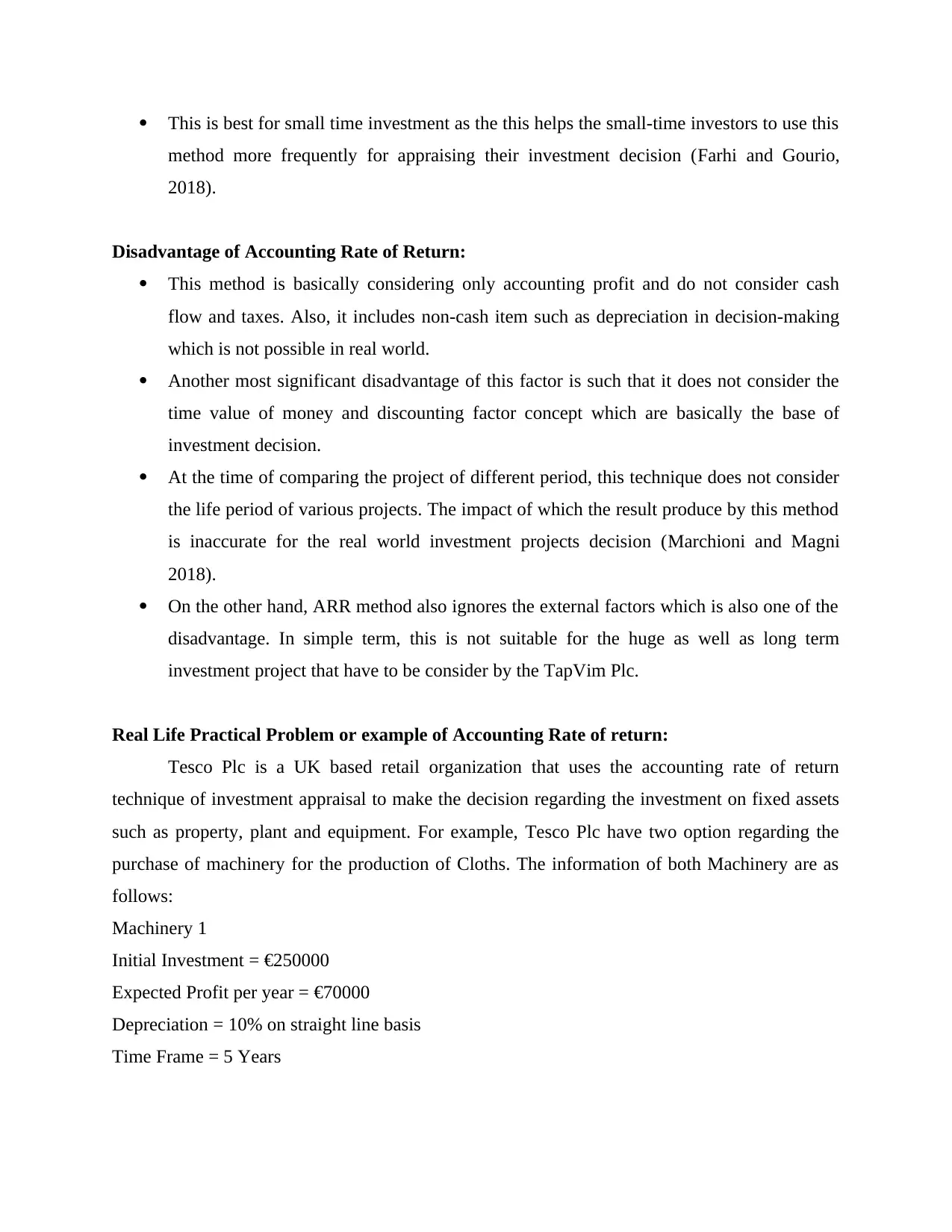
This is best for small time investment as the this helps the small-time investors to use this
method more frequently for appraising their investment decision (Farhi and Gourio,
2018).
Disadvantage of Accounting Rate of Return:
This method is basically considering only accounting profit and do not consider cash
flow and taxes. Also, it includes non-cash item such as depreciation in decision-making
which is not possible in real world.
Another most significant disadvantage of this factor is such that it does not consider the
time value of money and discounting factor concept which are basically the base of
investment decision.
At the time of comparing the project of different period, this technique does not consider
the life period of various projects. The impact of which the result produce by this method
is inaccurate for the real world investment projects decision (Marchioni and Magni
2018).
On the other hand, ARR method also ignores the external factors which is also one of the
disadvantage. In simple term, this is not suitable for the huge as well as long term
investment project that have to be consider by the TapVim Plc.
Real Life Practical Problem or example of Accounting Rate of return:
Tesco Plc is a UK based retail organization that uses the accounting rate of return
technique of investment appraisal to make the decision regarding the investment on fixed assets
such as property, plant and equipment. For example, Tesco Plc have two option regarding the
purchase of machinery for the production of Cloths. The information of both Machinery are as
follows:
Machinery 1
Initial Investment = €250000
Expected Profit per year = €70000
Depreciation = 10% on straight line basis
Time Frame = 5 Years
method more frequently for appraising their investment decision (Farhi and Gourio,
2018).
Disadvantage of Accounting Rate of Return:
This method is basically considering only accounting profit and do not consider cash
flow and taxes. Also, it includes non-cash item such as depreciation in decision-making
which is not possible in real world.
Another most significant disadvantage of this factor is such that it does not consider the
time value of money and discounting factor concept which are basically the base of
investment decision.
At the time of comparing the project of different period, this technique does not consider
the life period of various projects. The impact of which the result produce by this method
is inaccurate for the real world investment projects decision (Marchioni and Magni
2018).
On the other hand, ARR method also ignores the external factors which is also one of the
disadvantage. In simple term, this is not suitable for the huge as well as long term
investment project that have to be consider by the TapVim Plc.
Real Life Practical Problem or example of Accounting Rate of return:
Tesco Plc is a UK based retail organization that uses the accounting rate of return
technique of investment appraisal to make the decision regarding the investment on fixed assets
such as property, plant and equipment. For example, Tesco Plc have two option regarding the
purchase of machinery for the production of Cloths. The information of both Machinery are as
follows:
Machinery 1
Initial Investment = €250000
Expected Profit per year = €70000
Depreciation = 10% on straight line basis
Time Frame = 5 Years
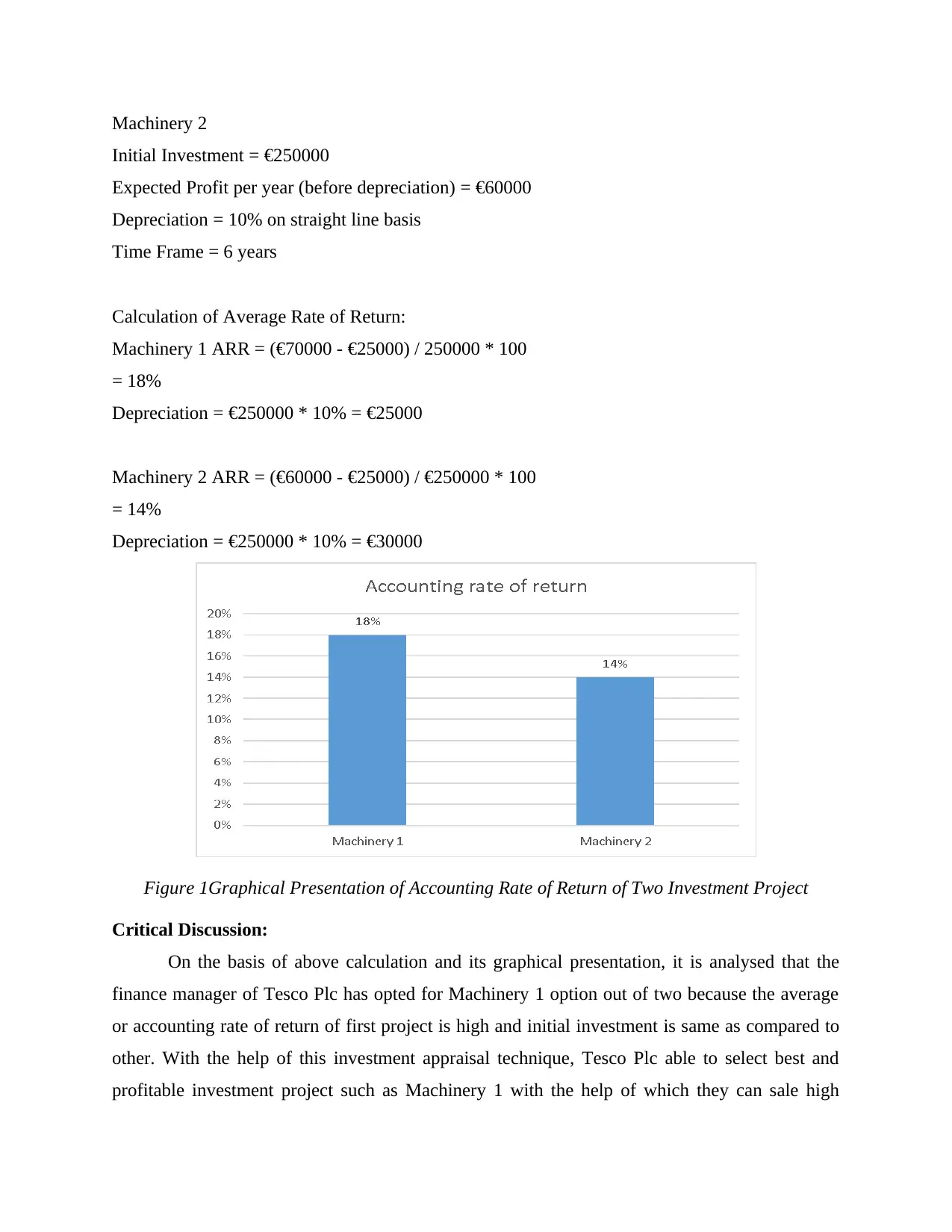
Machinery 2
Initial Investment = €250000
Expected Profit per year (before depreciation) = €60000
Depreciation = 10% on straight line basis
Time Frame = 6 years
Calculation of Average Rate of Return:
Machinery 1 ARR = (€70000 - €25000) / 250000 * 100
= 18%
Depreciation = €250000 * 10% = €25000
Machinery 2 ARR = (€60000 - €25000) / €250000 * 100
= 14%
Depreciation = €250000 * 10% = €30000
Figure 1Graphical Presentation of Accounting Rate of Return of Two Investment Project
Critical Discussion:
On the basis of above calculation and its graphical presentation, it is analysed that the
finance manager of Tesco Plc has opted for Machinery 1 option out of two because the average
or accounting rate of return of first project is high and initial investment is same as compared to
other. With the help of this investment appraisal technique, Tesco Plc able to select best and
profitable investment project such as Machinery 1 with the help of which they can sale high
Initial Investment = €250000
Expected Profit per year (before depreciation) = €60000
Depreciation = 10% on straight line basis
Time Frame = 6 years
Calculation of Average Rate of Return:
Machinery 1 ARR = (€70000 - €25000) / 250000 * 100
= 18%
Depreciation = €250000 * 10% = €25000
Machinery 2 ARR = (€60000 - €25000) / €250000 * 100
= 14%
Depreciation = €250000 * 10% = €30000
Figure 1Graphical Presentation of Accounting Rate of Return of Two Investment Project
Critical Discussion:
On the basis of above calculation and its graphical presentation, it is analysed that the
finance manager of Tesco Plc has opted for Machinery 1 option out of two because the average
or accounting rate of return of first project is high and initial investment is same as compared to
other. With the help of this investment appraisal technique, Tesco Plc able to select best and
profitable investment project such as Machinery 1 with the help of which they can sale high
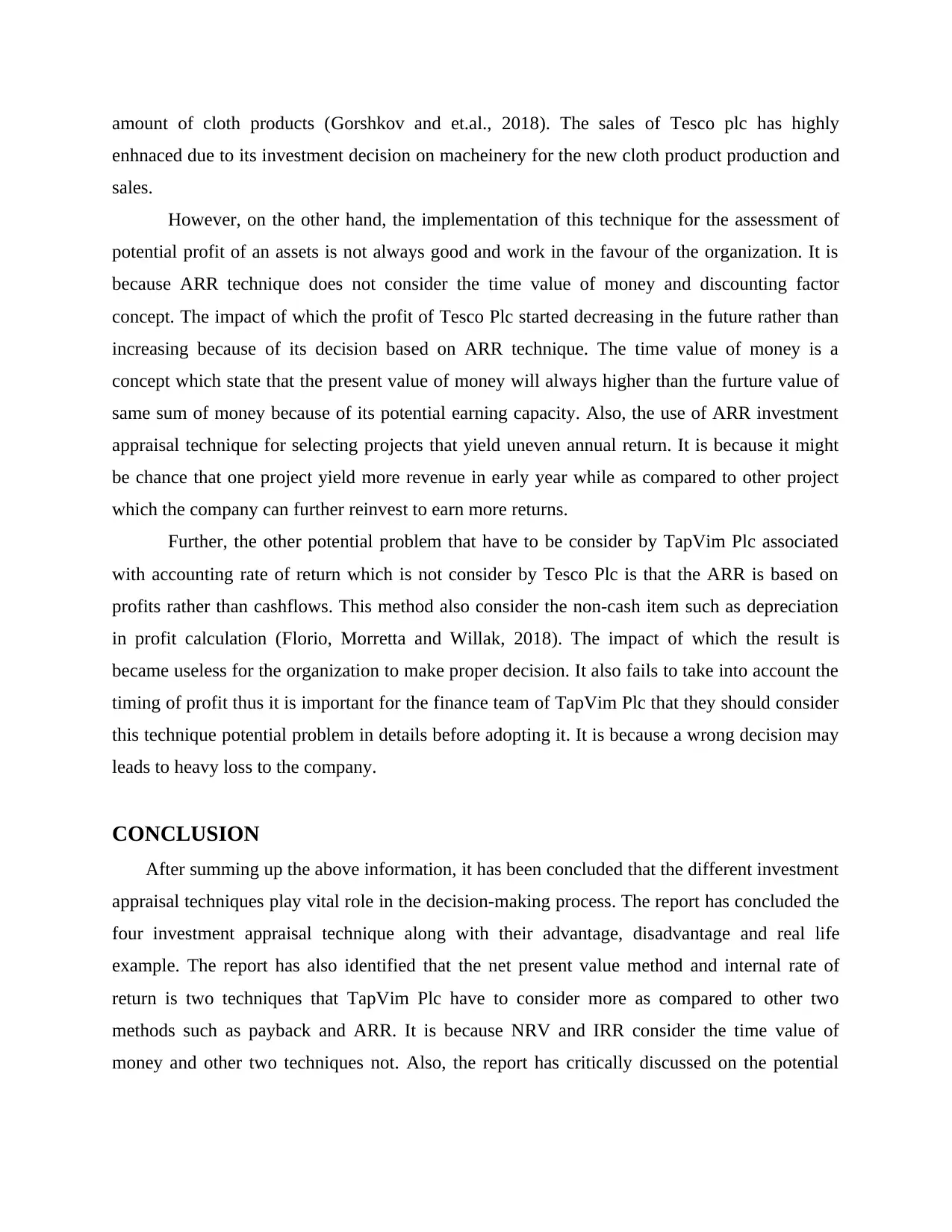
amount of cloth products (Gorshkov and et.al., 2018). The sales of Tesco plc has highly
enhnaced due to its investment decision on macheinery for the new cloth product production and
sales.
However, on the other hand, the implementation of this technique for the assessment of
potential profit of an assets is not always good and work in the favour of the organization. It is
because ARR technique does not consider the time value of money and discounting factor
concept. The impact of which the profit of Tesco Plc started decreasing in the future rather than
increasing because of its decision based on ARR technique. The time value of money is a
concept which state that the present value of money will always higher than the furture value of
same sum of money because of its potential earning capacity. Also, the use of ARR investment
appraisal technique for selecting projects that yield uneven annual return. It is because it might
be chance that one project yield more revenue in early year while as compared to other project
which the company can further reinvest to earn more returns.
Further, the other potential problem that have to be consider by TapVim Plc associated
with accounting rate of return which is not consider by Tesco Plc is that the ARR is based on
profits rather than cashflows. This method also consider the non-cash item such as depreciation
in profit calculation (Florio, Morretta and Willak, 2018). The impact of which the result is
became useless for the organization to make proper decision. It also fails to take into account the
timing of profit thus it is important for the finance team of TapVim Plc that they should consider
this technique potential problem in details before adopting it. It is because a wrong decision may
leads to heavy loss to the company.
CONCLUSION
After summing up the above information, it has been concluded that the different investment
appraisal techniques play vital role in the decision-making process. The report has concluded the
four investment appraisal technique along with their advantage, disadvantage and real life
example. The report has also identified that the net present value method and internal rate of
return is two techniques that TapVim Plc have to consider more as compared to other two
methods such as payback and ARR. It is because NRV and IRR consider the time value of
money and other two techniques not. Also, the report has critically discussed on the potential
enhnaced due to its investment decision on macheinery for the new cloth product production and
sales.
However, on the other hand, the implementation of this technique for the assessment of
potential profit of an assets is not always good and work in the favour of the organization. It is
because ARR technique does not consider the time value of money and discounting factor
concept. The impact of which the profit of Tesco Plc started decreasing in the future rather than
increasing because of its decision based on ARR technique. The time value of money is a
concept which state that the present value of money will always higher than the furture value of
same sum of money because of its potential earning capacity. Also, the use of ARR investment
appraisal technique for selecting projects that yield uneven annual return. It is because it might
be chance that one project yield more revenue in early year while as compared to other project
which the company can further reinvest to earn more returns.
Further, the other potential problem that have to be consider by TapVim Plc associated
with accounting rate of return which is not consider by Tesco Plc is that the ARR is based on
profits rather than cashflows. This method also consider the non-cash item such as depreciation
in profit calculation (Florio, Morretta and Willak, 2018). The impact of which the result is
became useless for the organization to make proper decision. It also fails to take into account the
timing of profit thus it is important for the finance team of TapVim Plc that they should consider
this technique potential problem in details before adopting it. It is because a wrong decision may
leads to heavy loss to the company.
CONCLUSION
After summing up the above information, it has been concluded that the different investment
appraisal techniques play vital role in the decision-making process. The report has concluded the
four investment appraisal technique along with their advantage, disadvantage and real life
example. The report has also identified that the net present value method and internal rate of
return is two techniques that TapVim Plc have to consider more as compared to other two
methods such as payback and ARR. It is because NRV and IRR consider the time value of
money and other two techniques not. Also, the report has critically discussed on the potential
Paraphrase This Document
Need a fresh take? Get an instant paraphrase of this document with our AI Paraphraser

problem that might face by TapVim Plc finance team while using this investment appraisal
techniques or methods.
techniques or methods.
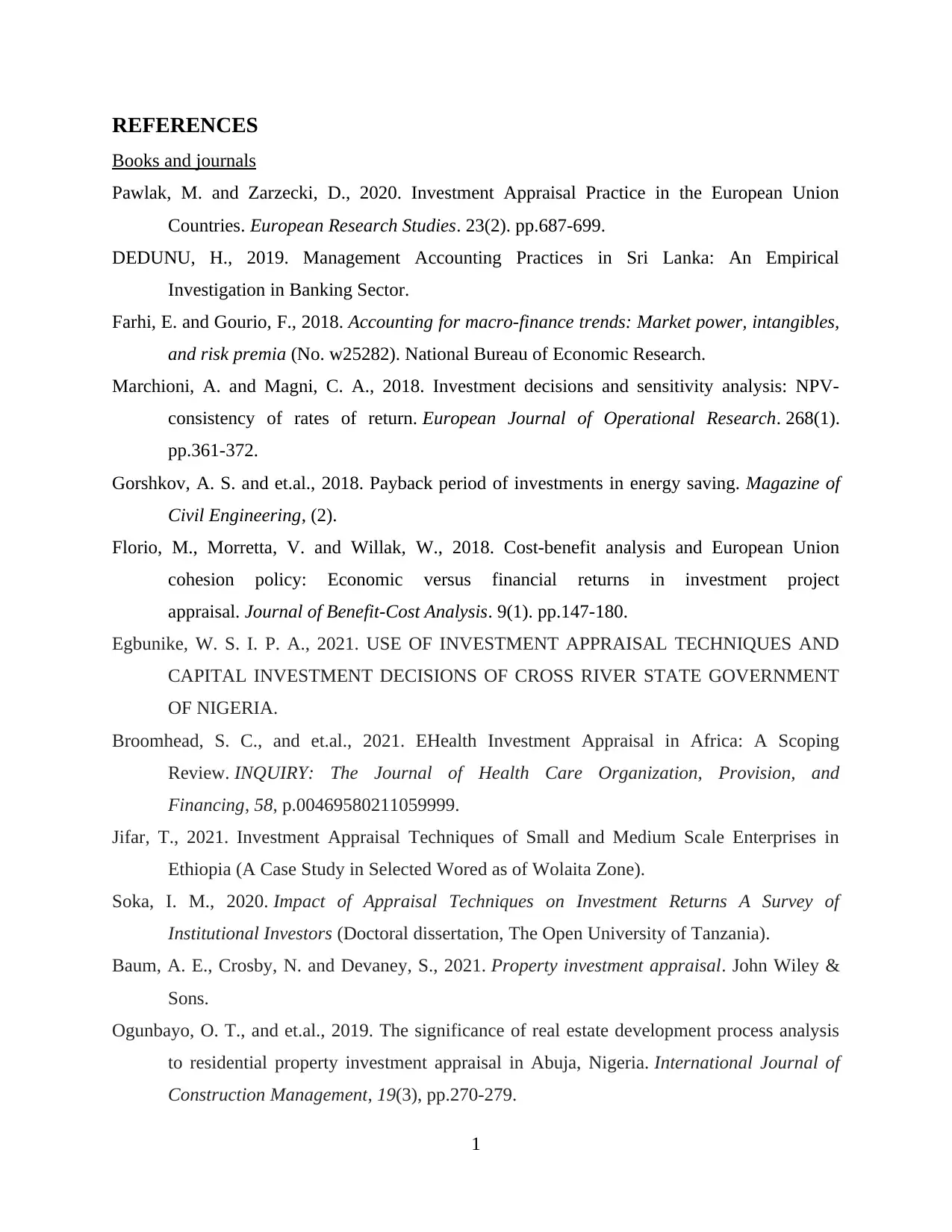
REFERENCES
Books and journals
Pawlak, M. and Zarzecki, D., 2020. Investment Appraisal Practice in the European Union
Countries. European Research Studies. 23(2). pp.687-699.
DEDUNU, H., 2019. Management Accounting Practices in Sri Lanka: An Empirical
Investigation in Banking Sector.
Farhi, E. and Gourio, F., 2018. Accounting for macro-finance trends: Market power, intangibles,
and risk premia (No. w25282). National Bureau of Economic Research.
Marchioni, A. and Magni, C. A., 2018. Investment decisions and sensitivity analysis: NPV-
consistency of rates of return. European Journal of Operational Research. 268(1).
pp.361-372.
Gorshkov, A. S. and et.al., 2018. Payback period of investments in energy saving. Magazine of
Civil Engineering, (2).
Florio, M., Morretta, V. and Willak, W., 2018. Cost-benefit analysis and European Union
cohesion policy: Economic versus financial returns in investment project
appraisal. Journal of Benefit-Cost Analysis. 9(1). pp.147-180.
Egbunike, W. S. I. P. A., 2021. USE OF INVESTMENT APPRAISAL TECHNIQUES AND
CAPITAL INVESTMENT DECISIONS OF CROSS RIVER STATE GOVERNMENT
OF NIGERIA.
Broomhead, S. C., and et.al., 2021. EHealth Investment Appraisal in Africa: A Scoping
Review. INQUIRY: The Journal of Health Care Organization, Provision, and
Financing, 58, p.00469580211059999.
Jifar, T., 2021. Investment Appraisal Techniques of Small and Medium Scale Enterprises in
Ethiopia (A Case Study in Selected Wored as of Wolaita Zone).
Soka, I. M., 2020. Impact of Appraisal Techniques on Investment Returns A Survey of
Institutional Investors (Doctoral dissertation, The Open University of Tanzania).
Baum, A. E., Crosby, N. and Devaney, S., 2021. Property investment appraisal. John Wiley &
Sons.
Ogunbayo, O. T., and et.al., 2019. The significance of real estate development process analysis
to residential property investment appraisal in Abuja, Nigeria. International Journal of
Construction Management, 19(3), pp.270-279.
1
Books and journals
Pawlak, M. and Zarzecki, D., 2020. Investment Appraisal Practice in the European Union
Countries. European Research Studies. 23(2). pp.687-699.
DEDUNU, H., 2019. Management Accounting Practices in Sri Lanka: An Empirical
Investigation in Banking Sector.
Farhi, E. and Gourio, F., 2018. Accounting for macro-finance trends: Market power, intangibles,
and risk premia (No. w25282). National Bureau of Economic Research.
Marchioni, A. and Magni, C. A., 2018. Investment decisions and sensitivity analysis: NPV-
consistency of rates of return. European Journal of Operational Research. 268(1).
pp.361-372.
Gorshkov, A. S. and et.al., 2018. Payback period of investments in energy saving. Magazine of
Civil Engineering, (2).
Florio, M., Morretta, V. and Willak, W., 2018. Cost-benefit analysis and European Union
cohesion policy: Economic versus financial returns in investment project
appraisal. Journal of Benefit-Cost Analysis. 9(1). pp.147-180.
Egbunike, W. S. I. P. A., 2021. USE OF INVESTMENT APPRAISAL TECHNIQUES AND
CAPITAL INVESTMENT DECISIONS OF CROSS RIVER STATE GOVERNMENT
OF NIGERIA.
Broomhead, S. C., and et.al., 2021. EHealth Investment Appraisal in Africa: A Scoping
Review. INQUIRY: The Journal of Health Care Organization, Provision, and
Financing, 58, p.00469580211059999.
Jifar, T., 2021. Investment Appraisal Techniques of Small and Medium Scale Enterprises in
Ethiopia (A Case Study in Selected Wored as of Wolaita Zone).
Soka, I. M., 2020. Impact of Appraisal Techniques on Investment Returns A Survey of
Institutional Investors (Doctoral dissertation, The Open University of Tanzania).
Baum, A. E., Crosby, N. and Devaney, S., 2021. Property investment appraisal. John Wiley &
Sons.
Ogunbayo, O. T., and et.al., 2019. The significance of real estate development process analysis
to residential property investment appraisal in Abuja, Nigeria. International Journal of
Construction Management, 19(3), pp.270-279.
1

Alkaraan, F., 2020. Strategic investment decision-making practices in large manufacturing
companies: a role for emergent analysis techniques?. Meditari Accountancy Research.
Warren, L. and Seal, W., 2018. Using investment appraisal models in strategic negotiation: The
cultural political economy of electricity generation. Accounting, organizations and
society, 70, pp.16-32.
2
companies: a role for emergent analysis techniques?. Meditari Accountancy Research.
Warren, L. and Seal, W., 2018. Using investment appraisal models in strategic negotiation: The
cultural political economy of electricity generation. Accounting, organizations and
society, 70, pp.16-32.
2
1 out of 16
Related Documents
Your All-in-One AI-Powered Toolkit for Academic Success.
+13062052269
info@desklib.com
Available 24*7 on WhatsApp / Email
![[object Object]](/_next/static/media/star-bottom.7253800d.svg)
Unlock your academic potential
© 2024 | Zucol Services PVT LTD | All rights reserved.




